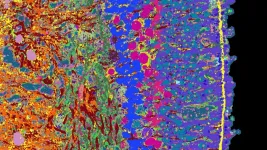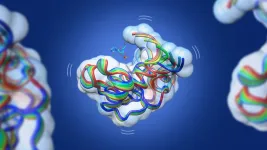(Press-News.org) In a new study in Nature Machine Intelligence*, researchers Bojian Yin and Sander Bohté from the HBP partner Dutch National Research Institute for Mathematics and Computer Science (CWI) demonstrate a significant step towards artificial intelligence that can be used in local devices like smartphones and in VR-like applications, while protecting privacy. They show how brain-like neurons combined with novel learning methods enable training fast and energy-efficient spiking neural networks on a large scale. Potential applications range from wearable AI to speech recognition and Augmented Reality.
While modern artificial neural networks are the backbone of the current AI revolution, they are only loosely inspired by networks of real, biological neurons such as our brain. The brain however is a much larger network, much more energy-efficient, and can respond ultra-fast when triggered by external events. Spiking neural networks are special types of neural networks that more closely mimic the working of biological neurons: the neurons of our nervous system communicate by exchanging electrical pulses, and they do so only sparingly.
Implemented in chips, called neuromorphic hardware, such spiking neural networks hold the promise of bringing AI programmes closer to users – on their own devices. These local solutions are good for privacy, robustness and responsiveness. Applications range from speech recognition in toys and appliances, health care monitoring and drone navigation to local surveillance.
Just like standard artificial neural networks, spiking neural networks need to be trained to perform such tasks well. However, the way in which such networks communicate poses serious challenges. "The algorithms needed for this require a lot of computer memory, allowing us to only train small network models mostly for smaller tasks. This holds back many practical AI applications so far," says Sander Bohté of CWI's Machine Learning group. In the Human Brain Project, he works on architectures and learning methods for hierarchical cognitive processing.
Mimicking the learning brain
The learning aspect of these algorithms is a big challenge, and they cannot match the learning ability of our brain. The brain can easily learn immediately from new experiences, by changing connections, or even by making new ones. The brain also needs far fewer examples to learn something and it works more energy-efficiently. "We wanted to develop something closer to the way our brain learns," says Bojian Yin.
Yin explains how this works: if you make a mistake during a driving lesson, you learn from it immediately. You correct your behaviour right away and not an hour later. "You learn, as it were, while taking in the new information. We wanted to mimic that by giving each neuron of the neural network a bit of information that is constantly updated. That way, the network learns how the information changes and doesn't have to remember all the previous information. This is the big difference from current networks, which have to work with all the previous changes. The current way of learning requires enormous computing power and thus a lot of memory and energy."
Six million neurons
The new online learning algorithm makes it possible to learn directly from the data, enabling much larger spiking neural networks. Together with researchers from TU Eindhoven and research partner Holst Centre, Bohté and Yin demonstrated this in a system designed for recognising and locating objects. Yin shows a video of a busy street in Amsterdam: the underlying spiking neural network, SPYv4, has been trained in such a way that it can distinguish cyclists, pedestrians and cars and indicate exactly where they are.
"Previously, we could train neural networks with up to 10,000 neurons; now, we can do the same quite easily for networks with more than six million neurons," says Bohté. "With this, we can train highly capable spiking neural networks like our SPYv4."
Future
And where does it all lead? Now having such powerful AI solutions based on spiking neural networks, chips are being developed that can run these AI programmes at very low power and will ultimately show up in many smart devices, like hearing-aides and augmented or virtual reality glasses.
END
Human Brain Project: Study presents large brain-like neural networks for AI
2023-05-08
ELSE PRESS RELEASES FROM THIS DATE:
Detailed image of the human retina
2023-05-08
What cell types are found in which human tissue, and where? Which genes are active in the individual cells, and which proteins are found there? Answers to these questions and more are to be provided by a specialised atlas – in particular how the different tissues form during embryonic development and what causes diseases. In creating this atlas, researchers aim to map not only tissue directly isolated from humans, but also structures called organoids. These are three-dimensional clumps of tissue that are cultivated in the laboratory and develop in a way similar ...
Welcoming Dr Ece Uzun, MS, PhD as the Editor-in-Chief for JMIR Bioinformatics and Biotechnology
2023-05-08
JMIR Bioinformatics and Biotechnology and JMIR Publications are thrilled to announce and welcome Dr Ece Uzun as Editor-in-Chief for JMIR Bioinformatics and Biotechnology.
Dr. Uzun is currently the Director of Clinical Bioinformatics and Associate Director of Clinical Cancer Informatics and Data Science (CCIDS) at Lifespan and an Assistant Professor of Pathology and Laboratory Medicine at Brown University Alpert Medical School. She has a B.S in Chemical Engineering and M.Sc in Biological Sciences and Bioengineering. She completed her PhD in Chemical Engineering at Northeastern University in 2010 and focused ...
Elucidating the mysteries of enzyme evolution at the macromolecular level
2023-05-08
Professor Nicolas Doucet and his team at Institut national de la recherche scientifique (INRS) made a major breakthrough earlier this year in the field of evolutionary conservation of molecular dynamics in enzymes. Their work, published in the journal Structure, points to potential applications in health, including the development of new drugs to treat serious diseases such as cancer or to counter antibiotic resistance.
As a researcher specializing in protein dynamics, Professor Doucet is captivated by things that are invisible to the naked eye, yet full of mysteries and essential to all forms of life. He studies proteins ...
Recent research advances on historical artifacts and their preservation
2023-05-08
Because we don’t have crystal balls to show us how the world used to look, scientists must rely on preserved artifacts and specimens to provide the details. Below are some recent papers published in ACS journals that have unearthed insights from historic items and provided suggestions for protecting relics. Reporters can request free access to these papers by emailing newsroom@acs.org.
“Two Pathways for the Degradation of Orpiment Pigment (As2S3) Found in Paintings”
Journal of the American Chemical Society
April 14, 2023
Oil paintings created before the 19th century often ...
Chinese Medical Journal review highlights the health hazards of air pollution
2023-05-08
Globally, air pollution is a major public health hazard. A key air pollutant linked to health risks is ambient fine particulate matter (PM2.5), which consists of minute particles, sized less than or equal to 2.5 μm, suspended in the air. According to the WHO, annual PM2.5 levels should not exceed 5 μg/m3. However, the current PM2.5 levels in China far exceed this standard and are responsible for approximately 1.4 million PM2.5-related excess deaths annually. Even as the country steadily works towards reducing ...
Researchers Identify the Standard for Gallbladder Cancer Surgery
2023-05-08
(Boston)—The quality of surgery can drastically influence both short- and long-term postoperative outcomes and is a crucial consideration in studies that assess surgical outcomes. One approach for developing accurate quality measures is benchmarking, a quality-improvement process in which the best possible outcomes are identified to serve as a point of reference against which performance can be compared.
Surgery for gallbladder cancer (GBC) is a technically challenging surgical procedure and requires considerable expertise ...
Mathematical model based on psychology predicts who will buy trendy products
2023-05-08
It’s often risky to introduce new products to the market. In fact, statistics show that between 40 to 90 percent of new products fail. A key component of product adoption is consumer psychology. While there are a few theories that attempt to explain why certain people are not likely to accept novelties, a new study takes a slightly different approach.
Florida Atlantic University and collaborators developed and introduced a new mathematical innovation model, grounded in psychology, to provide both qualitative and quantitative predictions of adoption trends for new products.
The objective of the study ...
New research shows how terrorism affects our language and the vote for the radical right
2023-05-08
The experience of the jihadist terrorist attacks that plagued Western Europe between 2015 and 2017 shows that perceived threats from ethnic and religious minorities affect the tone of public discourse about immigration and the support for radical right parties, according to a new study which uses German data, including more than 10mln tweets.
In that period, terrorist attacks and instances of crime involving minorities made immigration a more salient issue for voters, explain Bocconi scholars Francesco Giavazzi (Bocconi University, Milan) and Gaia Rubera (Bocconi ...
Hormone therapy increases lumbar spine bone mineral density, protects against bone loss
2023-05-08
CLEVELAND, Ohio (May 8, 2023)—As the population continues to age, there is greater focus on bone health and minimizing fractures to maintain mobility. A new study suggests that various types of hormone therapies not only increase lumbar spine bone mineral density (BMD) in postmenopausal women but also protect against bone loss, even after hormones have been discontinued. Study results are published online in Menopause, the journal of The North American Menopause Society (NAMS).
Osteoporosis is a common debilitating condition, ...
NIH Trailblazer Award will use advanced AI to improve outcomes for heart patients
2023-05-08
Pacemakers and other implantable devices that restore normal heart rhythms have saved millions of lives.
In some patients, a pacemaker or implantable cardioverter defibrillator modified for “cardiac resynchronization therapy,” or CRT, can dramatically improve heart failure by synchronizing the heart’s pumping function. Unfortunately, many people don’t respond to CRT and of those who do, some don’t realize its full potential — including increased exercise capacity and staying out of the hospital.
CRT can save or change many more lives, says Miaomiao Zhang, an assistant professor at the University of Virginia School ...





